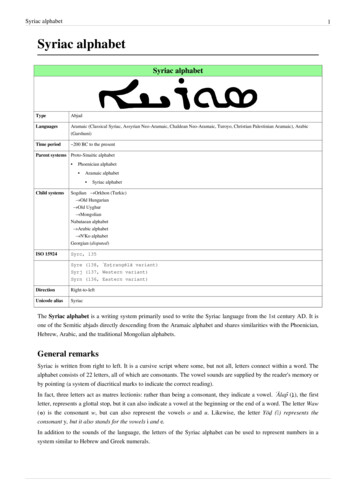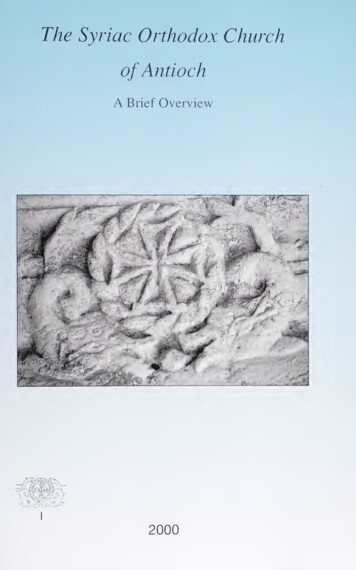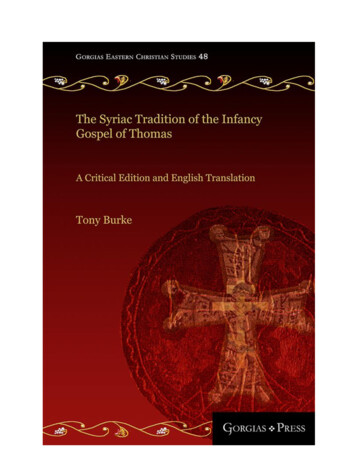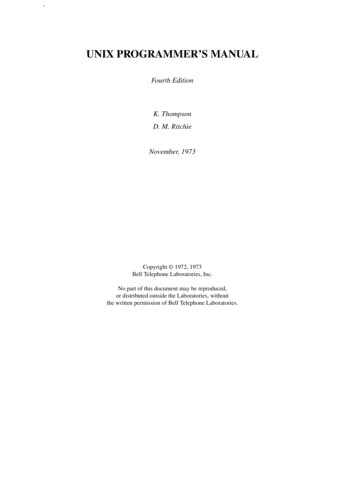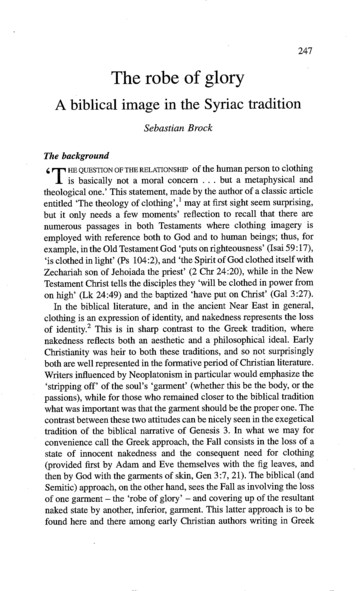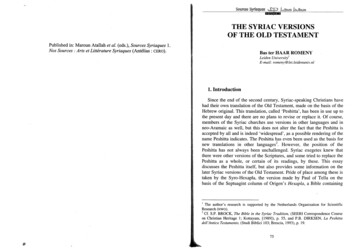
Transcription
DiJIIifii pTHE SYRIAC VERSIONSOF THE OLD TESTAMENTPublished in: Maroun Atallah et al. (eds.), Sources Syriaques 1.Nos Sources: Arts et Litterature Syriaques (AnU:lias: CERO).Bas ter HAAR ROMENYLeiden University 1 -mail: romeny@ let.leidenuniv.nl1. IntroductionSince the end of the second century, Syriac-speaking Christians havehad their own translation of the Old Testament, made on the basis of theHebrew original. This translation, called 'Peshitta', has been in use up tothe present day and there are no plans to revise or replace it. Of course,members of the Syriac churches use versions in other languages and inneo-Aramaic as well, but this does not alter the fact that the Peshitta isaccepted by all and is indeed 'widespread', ftS a possible rendering of thename Peshitta indicates. The Peshitta has even been used as the basis fornew translations in other languages2 . However, the position of thePeshitta has not always been unchallenged. Syriac exegetes knew thatthere were other versions of the Scriptures, and some tried to replace thePeshitta as a whole, or certain of its readings, by these. This essaydiscusses the Peshitta itself, but also provides some information on thelater Syriac versions of the Old Testament. Pride of place among these istaken by the Syro-Hexapla, the version made by Paul of Tella on thebasis of the Septuagint column of Origen's Hexapla, a Bible containing1The author's research is supported by the Netherlands Organisation for ScientificResearch (NWO).2Cf. S.P. BROCK, The Bible in the Syriac Tradition, (SEERI Correspondence Courseon Christian Heritage I; Kottayam, [ 1989]), p. 55, and P.B. DIRKSEN, La Peshittadell'Antico Testamento, (Studi Biblici 103; Brescia, 1993), p. 19.75
The syriac versions of the Old Testamentthe Hebrew text as well as a number of Greek versions in six parallelcolumns.2. The Name 'Peshitta'It is only in the ninth century that we find the first attestation of thename 'Peshitta'. Moses bar Kepha (d. 903) uses the name in hisHexaemeron 3 and his Introduction to the Psalter4 . He explains that heknew of two translations in Syriac: the Peshitta, based on the Hebrewtext, and Paul ofTella's translation from the Greek text of the Septuagint.Earlier references, in Syriac as well as in Greek sources, simply refer to'the Syrian'.The word Peshitta is the feminine passive participle of the verb セL@'to stretch out, to extend' 5 . It presupposes the word mappaqta,'translation'. The precise sense of this participle is no longer clear. Inother contexts, it often means 'simple'. It is possible that this is also thesense when the word is applied to the Syriac Bible. Barhebraeus clearlyassumed this, as he says: ' . their translation, called Peshitta because itabstains from eloquent language in its translation, agrees with the text of3Der Hexaeineronkommentar des Moses bar Kepha, transl. L. Schlimme (GottingerOrientforschungen [GOF] I. Syriaca 14.1; Wiesbaden, 1977),, pp. 167-73. The Syriactext has not yet been edited.4Eine jakobitische Einleitung in den Psalter in Verbindung mit zwei Homilien aus demgrossen Psalmenkommentar des Daniel von Salah zum ersten Male herausgegeben,iibersetzt und bearbeitet, ed. and transl. G. Diettrich, (BZAW 5; Giessen, 1901), pp.I 06-16. For the attribution to Moses bar Kepha, see J.-M. VOSTE, 'L'introduction deMose bar Kepha aux Psaumes de David', Revue Biblique 38 (1929), pp. 214-28.5For a survey of the different opinions on the translation of the name 'Peshitta', seeP.B. DIRKSEN, 'The Old Testament Peshitta', in: M.J. Mulder (ed.), Mikra. Text,Translation, Reading, and Interpretation of the Hebrew Bible in Ancient Judaism andEarly Christianity (Compendia Rerum ludaicarum ad Novum Testamentum 2. TheLiterature of the Jewish People in the Period of the Second Temple and the Talmud 1(Assen/Maastricht-Philadelphia, 1988), p. 256.76the Jews' 6. Modem scholars, however, have suggested two other options.On the basis of the sense of the verb, L. Bertholdt and E. Nestle thoughtthe participle should be interpreted as 'widespread', in the sense of 'incommon use', just like the Latin word vulgata. The Syriac Bible basedon the Hebrew was indeed in common use, in contrast to the versionsmade on the basis of the Greek Septuagint, which never became verypopular. F. Field, on the other hand, accepted the usual sense of theparticiple, but interpreted it as 'single' rather than as 'abstaining fromeloquent language'. This also assumes that the name was intended tocontrast the version with the Syro-Hexapla, the word Hexapla meaning'six-fold'.3. Manuscripts and Other SourcesThe present editions of the Peshitta are based on manuscripts: codiceswritten on parchment or paper by hand. The oldest manuscripts date fromthe fifth century. One of these is the oldest dated biblical manuscript inany language: British Library Add 14512 (5ph1 according to the systemof the Peshitta Institute, in which the first digit refers to the century) fromthe year 771 'according to the Greeks', -that is, AD 459/60. This meansthat there is a gap of almost three hundred years between the years inwhich the Peshitta was translated and the oldest manuscript known to us.Several generations of copying separate the original translation and thecopies we have. In the course of this period, the text may of course havebeen changed or corrupted. To make things worse, the oldest manuscriptsdo not contain the Peshitta as a whole. 5ph1 contains fragments of Isaiahand Ezekiel. 5b 1, dated to 463/64, contains the Pentateuch, but the earlydate only applies to the first two books: Genesis and Exodus.The oldest complete Syriac Old Testament known to us is the socalled Codex Ambrosianus, from the Ambrosian Library in Milan (MS B.21 Inf.). As the name 7al in the Leiden edition indicates, this manuscript6This comes from Barhebraeus' Compendious History of Dynasties, written in Arabic.The text is quoted in N. WISEMAN, Horae Syriacae, seu commentationes et anecdotares vellitteras Syriacas spectantia (Rome, 1828), pp. 92-94.77
セャゥZᆴis@The syriac versions of the Old Testamentmay have been written in the seventh century. As it is not dated, this isjust an educated guess; some have opted for the sixth century. There areonly a few of such complete Bibles or pandects. We may assume thattheir text is of a composite nature: the copyist probably had to usebiblical manuscripts containing smaller groups of books as his model.This is also reflected in the order and choice of books, which appears notto have been seen as being completely fixed. Some features are shared byseveral pandects, such as the fact that Job follows immediately after thePentateuch (perhaps he was associated with the patriarchal era, as he wasidentified with Jobab of Gen. 10:29) and that all books on women weregrouped together (Ruth, Susanna, Esther, and Judith). The first featurehas been reproduced in Lee's edition. The pandects also contain anumber of books that are considered apocryphal or deutero-canonical bywestern churches, and some works that are not even part of this category,such as IV Ezra and the Apocalypse of Baruch.In light of the distance between the original translation and the oldestmanuscripts, it is very important to use all additional sources we can find.The Peshitta is already quoted in the Diatessaron, it would seem7. ThisGospel harmony from the second century, or at least the Syriac version ofit, may have taken quotations from the Old Testament from the Peshittarather than from the Greek text of the Gospels. Unfortunately, full copiesof the Syriac text of the Diatessaron itself have not come down to us; ithas to be reconstructed on the basis of quotations. A very important .source of direct quotations from the Old Testament Peshitta is formed bythe quotations of the fourth-century Syriac father Ephrem the Syrian8 His Commentary on Genesis and Exodus in particular contains manyliteral translations, which show that he had a copy of the biblical text athand. Aphrahat' s quotations, from the same century, are less reliable. He7Sebastian P. BROCK, 'Limitations of Syriac in Representing Greek', in Bruce M.Metzger, The Early Versions of the New Testament: Their Origin, Transmission, andLimitations, (Oxford, 1977), pp. 83-98, especially 97-98. This position is stronglyadvocated by Jan JOOSTEN, 'The Old Testament Quotations in the Old Syriac andPeshitta Gospels: A Contribution to the Study of the Diatessaron', Textus 15 (1990), pp.55-76.8A.G.P. JANSON, De Abrahamcyclus in de Genesiscommentaar van Efrem de Syrier,(doctoral dissertation Leiden; Zoetermeer, IZス@Jbl)@!§§l jォNセ@"'"'A* *'appears to have cited from memory in a loose manner9 A specialcategory of Peshitta quotations is formed by the readings of 'the Syrian'HlオーッセI@in Greek exegetes. Eusebius of Emesa, a contemporary ofEphrem, born in Edessa and bilingual, wrote commentaries in Greek onthe Septuagint. At some instances he translated the reading of thePeshitta for his Greek public, as an alternative to a difficult Septuagintreading. Most of the Greek Peshitta quotations in other authors derivefrom him; Theodoret of Cyrrhus (d. c.458) seems to have been the only10other Greek exegete who had independent access to a Syriac Bible Together with Ephrem and Aphrahat, Eusebius and Theodoret are themain witnesses to the Peshitta text before the earliest surviving biblicalmanuscript.4. Text EditionsThe first printed edition of part of the Syriac Bible was the edition ofthe Psalms that was published in Quzhaya, Lebanon, in 161 0-in fact thefirst work printed in this country. It was followed in 1625 by two moreeditions of the Psalms: that of the Maronite Gabriel Sionita, published inParis, and that of Thomas van Erpe (Erpenius), a famous professor ofArabic, printed in Leiden, the Netherlands. The latter edition is stillimportant for some of its conjectures.The first printed edition of the Peshitta as a whole is found in theParis Polyglot. A Polyglot prints the biblical text in several languages forcomparison. The Syriac text, edited by Gabriel Sionita, appeared in 1645.It was based, unfortunately, on a rather poor manuscript: 17a5 (Paris,Bibliotheque Nationale, Syr. 6). In its turn, the Paris Polyglot became thebasis of the London Polyglot published by Brian Walton in 1657. Thisedition adds a number of variant readings from manuscripts present in9Robert J. OWENS·, Jr., The Genesis and Exodus Citations of Aphrahat the PersianSage, (MPIL 3; Leiden, 1983).10R.B. ter Haar ROMENY, A Syrian in Greek Dress. The Use of Greek, Hebrew, andSyriac Biblical Texts in Eusebius of Emesa's Commentary on Genesis, (TraditioExegetica Graeca 6; Leuven, 1997), pp. 71-86.79
The syriac versions of the Old TestamentEnglish libraries, but otherwise just reproduces the Paris text. The textmost widely available today goes back to that of Walton, and thuseventually to the Paris manuscript 17a5: in 1823 Samuel Lee publishedhis edition of the Peshitta under the auspices of the British and ForeignBible Society, adopting the text of the London Polyglot while makingsome use of the so-called Buchanan Bible (manuscript 12al, broughtfrom India to Cambridge by the missionary Claude Buchanan). Thisedition was intended originally for the Syriac churches on the Malabarcoast in India, but it received a much wider circulation. The United BibleSocieties have been publishing reprints of Lee's edition up to this day.Whereas Lee's edition was printed in the West Syrian serto script, thesame century also saw two editions in East Syrian type: the so-calledUrmia and Mosul Bibles. In 1852 the former appeared. It had beenprepared by Justin Perkins, a Methodist missionary sent to Urmia inp・Nイウゥセ@in 1834 by the American Board of Commissioners for ForeignMtsswns of Boston, Massachusetts. The purpose of this mission was, asthey expressed it, to raise the spiritual and cultural level of the'Nestorians'. In parallel columns, it gives the text of the Peshitta basedon Lee's edition, corrected in some instances on the basis of a number ofmanuscripts that were available locally, and a new translation of theHebrew text into neo-Aramaic 11 It is assumed that the text of the Mosuledition, in its turn, goes back to the Urmia edition 12 The Dominicanswho published this edition in Mosul in 1887 for the Chaldaeans probablyalso mtroduced changes on the basis of local manuscripts, and added thetext of the apocryphal or deutero-canonical books. J.M. Voste prepared areprint of this edition with some corrections, which was published in1952 in Beirut. Another version of the Urmia edition was printed in 1913by the Trinitarian Bible Society in London.A nineteenth-century edition of a completely different nature wasA.M. Ceriani's facsimile publication of the manuscript 7al, the oldestcodex containing the complete text of the Peshitta, from the AmbrosianLibrary in Milan. It was published in the years 1876-83, using thetechnique of photolithography, which had just become available.Although the huge and expensive volumes did not gather a widecirculation, this publication was a landmark in Peshitta studies. For thefirst time, a text became available to a scholarly public that differedmarkedly from that of the Paris Polyglot. The fact that 7a1 containedvariants closer to the Hebrew sparked the discussion whether thesereadings reflected an original translation that was closer to the Hebrew,or were the result of a revision towards the Hebrew text (see§ 7 below).The first scientific edition, containing only the Psalms, was publishedby W.E. Barnes in 1904. He used 7a1 as his basic text, but corrected it onthe basis of a number of other manuscripts. With the help of C.W.Mitchell and J. Pinkerton, the same author also published a new editionof the Pentateuch in 1914. This edition gives a corrected version of Lee'stext. In order to gain a full picture of the text history of the Peshitta, itwas necessary to collect all witnesses available in libraries in Europe andthe United States as well as in the Middle East. It was not until 1959,however, that the International Organization for the Study of the OldTestament decided to start the Peshitta project, which was entrusted tothe Leiden Peshitta Institute. The first phase of this project entailedmaking a list of all Peshitta manuscripts and procuring microfilms of allof them. This work, which included expeditions to the Middle East,occupied the collaborators of the Institute for more than a decade. Apreliminary List of Old Testament Peshitta Manuscripts appeared in1961. It was in 1972 that the first volume of the new edition appeared,under the title The Old Testament in Syriac according to the PeshittaVersion.The original idea of the Leiden edition was to print the basic text,.usually 7a1, without any changes, 'except for the correction of obviousclerical errors that do not make sense' as the 1972 General Preface13 'states . All other readmgs would be relegated to the critical apparatus,the list of variant readings. After publication of fascicles 3 and 6 of part11P.B. DIRKSEN, 'The Urmia Edition of the Peshitta: The Story behind the Text'Textus 18 (1995), pp. 157-67. '12DIRKSEN, 'The Old Testament Peshitta', p. 257.Peshitta Institute Leiden, The Old Testament in Syriac according to the PeshittaVersion: General Preface, (Leiden, I 972), p. viii.808113
! he syriac versions of the Old TestamentpAIIIUCWMIV of the edition, contammg the Apocalypse of Baruch, 4 Esdras,Canticles or Odes, Prayer of Manasseh, Apocryphal Psalms, Psalms ofSolomon, Tobit, and 1 (3) Esdras, it appeared that the size of theapparatus would be too large, making the undertaking impossible forfinancial reasons. Piet de Boer and Wim Baars, then general editors,decided to omit all variant readings occurring only in manuscriptsyounger than the twelfth century, and to widen the scope for emendationsin the basic text. The first decision can only be defended if it can bedemonstrated that the later manuscripts all go back to existing earliermanuscripts. This would indeed seem to be the case, in the sense thatthere is a general impression, based on full or sample collations, thatthese manuscripts do not carry unknown variants that cannot beexplained as inner-Syriac corruptions or changes. Still, it has beendecided to publish the variants of manuscripts up to and including theriftccnth century in a separate volume.text: one that tries to come as close to the original as possible. It was noteven the intention to correct as many mistakes and changes in 7a I aspossible: only readings deemed impossible or readings not supported bytwo or more manuscripts were to be emended.In hindsight, one must say that from the point of view of text-criticalmethod, the introduction of the majority principle and the resulting mixedapproach of the Leiden edition are not commendable. De Boer himselfconceded that 'it is difficult to approve of the introduction ofemendations in the basic text' 16 One can only understand De Boer'sdecisions if one considers his aim. The text should be seen as a point ofreference: it should be common enough to guarantee a concise apparatus.His goal was to publish a text that could be used in further research. Themain text as such has no status; together with the apparatuses, it forms ado-it-yourself kit. As De Boer writes 17 :The second decision, the introduction of a larger number ofemendations, was also connected with the wish to make the apparatusleaner, 'thus facilitating the use of the edition and also its printing' 14 Themain rule for emendations should be seen in this light 15 :Emendations were made also in those cases where the readingof the manuscripts chosen as the basic text of the edition is notsupported by two or more manuscripts from the material used up toand including the tenth century. The printed text in these cases ischosen on the basis of a definite majority of the manuscripts datedto the tenth century or earlier.Thus the choice was made for something between a diplomaticedition- an edition which renders one manuscript faithfully like adiplomat- and a majority text. It was not intended as a so-called critical14P.A.H. de BOER, 'Towards an Edition of the Syriac Version of the Old Testament'(PlC 16), Vetus Testamentum 31 (1981), pp. 346-57 (356); cf. also De Boer's Preface,in Peshitta Institute Leiden. The Old Testament in Syriac according to the PeshittaVersion, I. I. Preface; Genesis-Exodus (Leiden: E.J. Brill, 1977), p. viii.15De BOER, 'Preface', p. viii.82The text printed in this edition - it must be stated expressisverbis - ought to be used in exegetical and textual study togetherwith the apparatuses.The reader cannot just quote the text, he should first go over theapparatus and do the work of the textual critic. De Boer himself was veryunhappy with the way the main text of the edition came to be quoted as'the Peshitta' without further ado. He admitted to have 'underestimatedthe force of the printed text even among scholars', and says not to blamehis successors if they come up with 'a system that that gives lessoccasion to misunderstanding' 18 Nowadays we think that the textual critic cannot leave his job - theselection of the correct readings from all available variants - to theuntrained reader just because he is uncertain whether his own choiceswill result in a reliable reconstruction of the original text. Moreover, thework on the present edition has greatly expanded our knowledge of the16DE BOER, 'Towards an Edition', p. 356.DE BOER, 'Preface', p. viii.18DE BOER, 'Towards an Edition', pp. 356-57.1783
.,.The syriac versions of the Old Testamenttext history of the Peshitta, and recent editions and studies of some of theSyriac Fathers have made additional evidence available. For thesereasons, the Peshitta Institute is making plans to publish a real criticaltext as well. However, this project will not be started before the presentedition, which is already a giant leap ahead, and which should lay thefoundation of this work, has been completed.5. ToolsWhat I have just written indicates that the main tool for the study ofthe Peshitta of the Old Testament is the Leiden Peshitta edition with itsapparatus of variant readings. Its main text, based on the Milan codex7a I, is already much better than any of the nineteenth-century editions,and the apparatus offers all known variants from biblical manuscriptswritten before the year 1200. Together the main text and apparatus give afull picture of the tradition of the biblical manuscripts of the variousSyriac traditions, enabling the reader to establish which text he deemsclosest to the original translation. Alternatively, the reader can choose thereadings of the later standard text, which was established in the ninthcentury (see § 7 below). The edition will consist of 17 volumes, 13 ofwhich have now appeared. The Peshitta Institute intends to publishadditional volumes with the variants of biblical manuscripts up to andincluding the fifteenth century, as well as studies of the text of the Syrianfathers. The main text of the edition is also available in electronic formatthrough the website of the Comprehensive Aramaic Lexicon(http://call.cn.huc.edu/).Translation into English. The Peshitta has been translated intoEnglish by George M. Lamsa 19 Unfortunately, this translation has beenassimilated to the Hebrew text in quite a few places, and is not based on areliable text of the Peshitta. The latter point also applies to Andrew19The Holy Bible from Ancient Eastern Manuscripts Containing the Old and NewTestament Translated from the Peshitta, the Authorized Bible of the Church of the East,(Philadelphia, 15th edn., 1967).Oliver's lesser known translation of the Peshitta Psalter20 It would bebest not to use Lamsa's version. A new English annotated translation isnow being prepared by a group of scholars as one of the Leiden PeshittaInstitute's projects. It will appear under the title The Bible of Edessa 21 Concordances. The first concordance of the Peshitta was publishedby the team of Werner Strothmann in Gottingen, Germany 22 Unfortunately, the textual basis of this concordance is not very good.Strothmann assumed that he could use Walton's Polyglot as a witness tothe West Syrian tradition, and the Urmia edition as a witness to that ofthe East Syrians. Even if the idea of a western and an eastern recension ofthe text had been correct, the choice of these two witnesses would havebeen a mistake: both editions eventually go back to the same Parismanuscript 17a5, which, to make things worse, is of poor quality. In thisrespect, Strothmann's concordance will be replaced by one based on theLeiden edition with variants. The first of the six volumes, containing theconcordance of the Pentateuch, has already appeared 23 . This newconcordance ·also lists the variants in the main nineteenth-centuryeditions. The words are arranged in alphabetical order as they appear inthe text, as in J. Payne Smith's Compendious Syriac Dictionary.Strothmann' s concordance lists the words according to their root, as in R.20A Translation of the Syriac Peshito Version of the Psalms of David, (Boston, 1861;New York, 1867).21Cf. Konrad JENNER et al., 'The New English Annotated Translation of the SyriacBible (NEATSB): Retrospect and Prospect' (PlC 23), Aramaic Studies 2 (2004), pp. 85106.22W. STROTHMANN, Konkordanz des Syrischen Koheletbuches nach der Peshittaund der Syrohexapla, (GOF 1.4; Wiesbaden, 1973); N. SPRENGER, Konkordanz zumSyrischen Psalter, (GOF 1.10; Wiesbaden, 1976); W. STROTHMANN et al.,Konkordanz zur Syrischen Bibel: Die Propheten, (GOF 1.25; Wiesbaden, 1984); W.sセrothman@et al., Konkordanz zur Syrischen Bibel: Der Pentateuch, (GOF 1.26;Wiesbaden, 1986); W. STROTHMANN et al., Konkordanz zur Syrischen Bibel: DieMautbe (GOF 1.33; Wiesbaden, 1995); W. STROTHMANN, Worterverzeichnis derapokryphen-deuterokanonischen Schriften des A/ten Testaments in der Peshitta, (GOF1.27; Wiesbaden, 1988). A list of names, not included in the above volumes, still has tobe published.23P.G. BORBONE et al., The ·Old Testament in Syriac according to the PeshittaVersion V. Concordance I. The Pentateuch, (Leiden, 1997).8485
.,. .The syriac versions of the Old TestamentPayne Smith's Thesaurus Syriac.us and in C. Brockelmann's LexiconSyriacum. As it will be important to have concordances orderedaccording to both principles, Strothmann's work will remain useful tosome extent.Bibliography. The Peshitta Institute collects all scholarly literature onthe Peshitta and other Syriac versions. A full bibliography of the Peshittaof the Old Testament was published in 198924 This collection wasbrought up to date (up to 1994) and corrected in a supplemene5 . Forliterature on the Peshitta published between 1995 and 1997, there is nobibliography at the moment, but one may consult Sebastian Brock'sgeneral bibliographies on Syriac studies, which are also most helpful forliterature on Syriac versions other than the Peshitta26 . The literaturepublished since 1998, on all Syriac versions as well as the Targumim(Jewish Aramaic versions of the Old testament), can be found in the'Bibliography of the Aramaic Bible', published in the Journal for theAramaic Bible, since 2003 continued under the title Aramaic Studies. Aselection of this material will be published on the website of the PeshittaInstitute, together with the data on 1995-1997. The Peshitta Institute alsohas its own monograph series with studies of the manuscript tradition,translation technique, and grammar of the Peshitta and other Syriac.27versiOns .24Commentaries. A very helpful source of information is formed by thebiblical commentaries of the Syriac Fathers28 They show how thePeshitta was interpreted in the course of the tradition. Authors likeEphrem the Syrian and Aphrahat, both from the fourth century, are nowavailable in good editions. The same applies to some of the Fathers whowere active after the split of the Syriac-speaking Church in the fifthcentury, though there is still much to 「セ@ done. Thus the East Syriancommentary of Isho'dad of Merv has recently been edited, but theimportant West Syrian commentaries of Dionysius bar Salibi and parts ofBarhebraeus Treasure of Mysteries are sti11 waiting to be published inreliable editions. Most Fathers were interested both in factual and inspiritual interpretations. The former deal with the facts of history, andcan still help us to see how they interpreted difficult passages. The latterform a timeless source of spirituality for all Christians.6. The Origin of the Peshitta6.1 Traditional ViewsThe earliest reference to the origins of the Peshitta is found inTheodore of Mopsuestia' s commentary on the Twelve Prophets. ThisGreek-speaking exegete (d. 428) says that the Syriac Bible was composed by some unknown man who often made mistakes, and even madeup stories. Therefore, he argues, this Syriac Bible could by no meanscompete with the Septuagint29 . Theodore was reacting against Eusebiusof Emesa (see § 3 above), an セ。イャゥ・@representative of the AntiocheneP.B. DIRKSEN, An Annotated Bibliography of the Peshitta of the Old Testament,(MPIL 5; Leiden, 1989).25P.B. DIRKSEN, 'Supplement to An Annotated Bibliography, 1989', in P.B. Dirksenand A. van der Kooij (eds.), The Peshitta as a Translation: Papers Read at the /IPeshitta Symposium Held at Leiden 19-21 August 1993, (MPIL 8; Leiden, 1995), pp.221-236.26From 1960 to 1990: S.P. BROCK, Syriac Studies: A Classified Bibliography (19601990). (Kaslik, 1996). From 1991 to 1995: S.P. BROCK, 'Syriac Studies: A ClassifiedBibliography (1991-1995)', Parole de !'Orient 23 (1998), pp. 241-350. From 1996 to2000: S.P. BROCK, 'Syriac Studies: A Classified Bibliography (1996-2000)', Parolede !'Orient 29 (2004), pp. 263-410. For earlier books on other versions, consult also C.MOSS, Catalogue of Syriac Books and Related Literature in the British Museum(London, 1962).27Monographs of the Peshitta Institute Leiden (MPIL), published by Brill.28A complete survey of Syriac biblical interpretation is found in two articles by LucasVAN ROMPAY: 'The Christian Syriac Tradition of Interpretation', in M. Srebl!l, ed.,Hebrew Bible/Old Testament. The History of Its Interpretation I. From the Beginningsto the Middle Ages (Until 1300) I. Antiquity (Gottingen, 1996), pp. 6I2-41, and'Development of Biblical Interpretation in the Syrian Churches of the Middle Ages', inM. Srebl!l, ed., Hebrew Bible/Old Testament. The History of Its Interpretation I. Fromthe Beginnings to the Middle Ages (Until 1300) 2. The Middle Ages (Gottingen, 2000),セpᄋ@559-77.9Theodori Mopsuesteni Commentarius in Xll prophetas, ed. H.N. Sprenger (GOF V.l;Wiesbaden, 1977), pp. 283-84, ad Zeph. I :4-6.8687
The syriac versions of the Old TestamentSchool of exegesis, to which Theodore also belonged. Eusebius haddefended the importance of the Hebrew text as the original version of theOld Testament, and had used informants and the Peshitta to get access toit. Eusebius knew that Syriac (his mother tongue) and Hebrew were'neighbours'. For this reason, he had accorded the Peshitta a specialstatus. For Theodore, however, the most reliable way to access theHebrew was via the Septuagint. He endorsed the view that the Septuagintwas a translation made by seventy very learned persons who hadindependently come to the same renderings, and that it was, furthermore,adopted by the Apostles, who handed it down to the Gentiles. Theodorewas anxious not to add anything to the biblical text. He was afraid ofspeculation 30 . The fact that it was unknown to him who had translated thePeshitta, made him shun the latter version.The next author who is know to have written about the origin of thePeshitta is the famous West Syrian polymath Jacob of Edessa (d. 708).The original text has not come down to us, but Moses bar Kepha (see§ 2above) quotes him as saying that the Peshitta was translated in the time ofking Abgar. In the second half of the eighth century, the East Syrianauthor Theod
Bible Society, adopting the text of the London Polyglot while making some use of the so-called Buchanan Bible (manuscript 12al, brought from India to Cambridge by the missionary Claude Buchanan). This edition was intended originally for the Syriac churches on the Malabar coast in India, but it received a much wider circulation.
